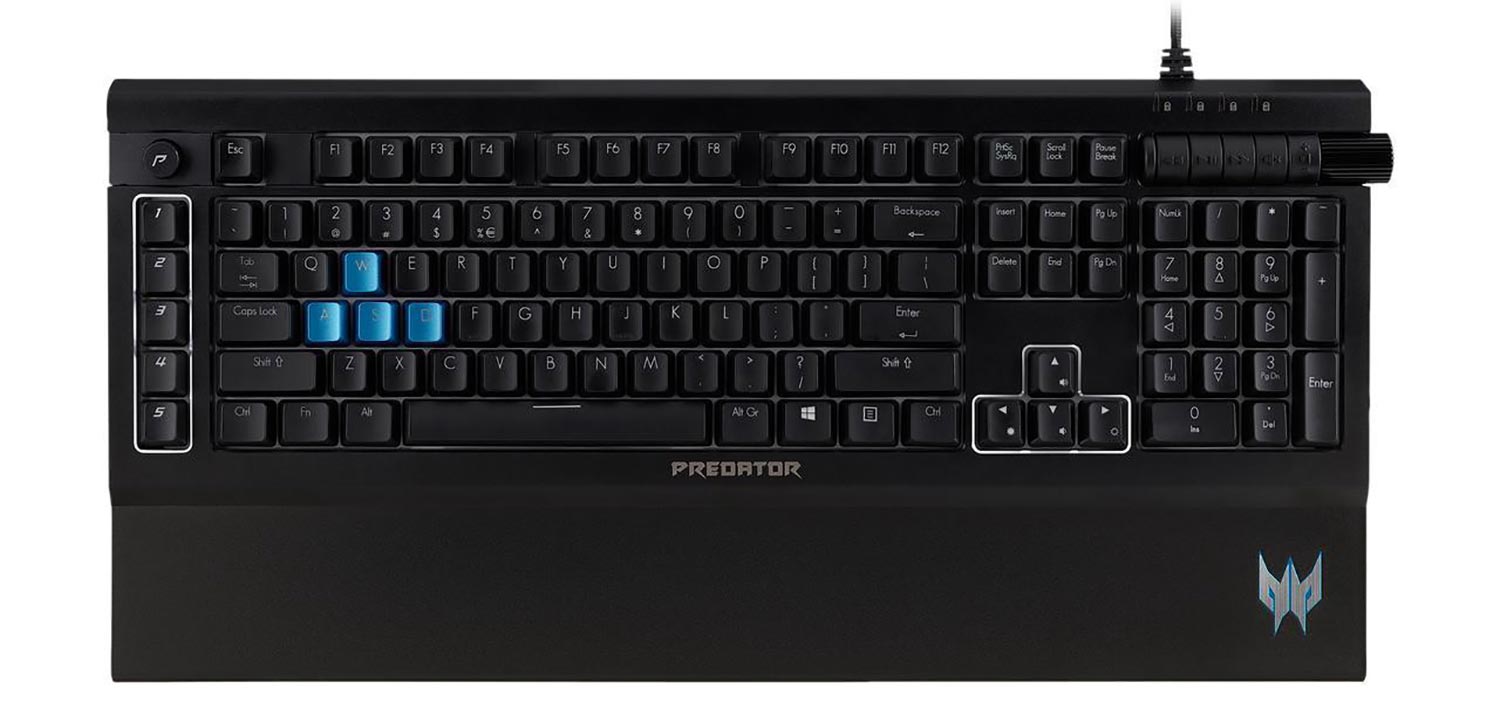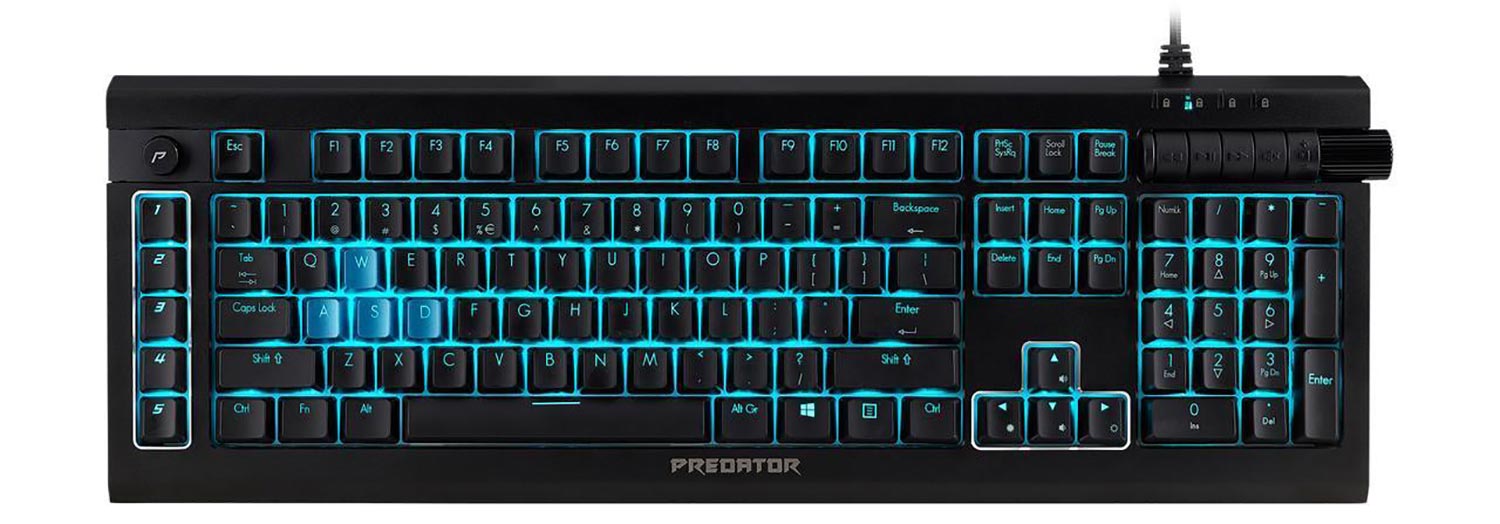Tom's Guide Verdict
Keep the Acer Predator Aethon 500 if it came with your new Acer PC; otherwise, you could do much better for the same price.
Pros
- +
Good game performance
- +
Discrete media keys
- +
Macro keys and profile button
Cons
- -
Strange, uneven design
- -
Clunky software
- -
Falls short of similarly priced competitors
Why you can trust Tom's Guide
Over the last few years, Razer, Logitech and especially Corsair have raised the bar in terms of what gamers can expect from keyboards. With top-of-the-line mechanical switches, robust RGB lighting and nuanced software, these keyboards can justify their $180 prices. The Acer Predator Aethon 500 ($180) has the same basic idea — and the same price — but cuts a lot of corners along the way.
Yes, the Aethon 500 has mechanical switches, but they're from a Cherry MX imitator. It has RGB lighting, but your effects options are limited. It has customizable software, but the program is clunky. From the media controls to the magnetic wrist rest, the Aethon 500 technically checks all of the "premium keyboard" boxes, but without the same attention to detail and comfort that you get from the major manufacturers. Keep this keyboard if it came with your new Acer PC; otherwise, you could do much better for the same price.
Design
The Aethon 500 is quite a large keyboard: 19.3 x 9.0 inches at its widest point with the wrist rest and 19.3 x 6.4 inches without. There are two primary reasons for this size: an extra row of five macro keys and a volume knob that extends out past the end of the keyboard. (This is one of the most baffling design choices I've seen on a keyboard in some time — more on that in a bit.) You'll need a pretty large desk to fit it all, while comparable models from Logitech and Razer (with rows of macro keys) tend to hover around 18.5 inches in length.
Size aside, the Aethon 500 looks pretty plain, with a black, aluminum chassis and a full-size keyboard. There's a magnetic wrist rest, but it's made of a flimsy-feeling plastic and doesn't stick on that well if you lift the keyboard up or try to move it. The W, A, S and D keys have shiny, blue keycaps rather than the standard black. They're pretty, but there's no option to swap them out, which you might want to do if you prefer uniformity.
There's also a discrete-media control bar — which is always a good thing — with nice, big buttons and a volume dial. However, the dial extends past the edge of the keyboard. My best guess is that Acer did this so that you can grasp the control from the side and treat it like a radio dial. But this is a needless extension that makes the whole keyboard look ugly and unbalanced. On the other hand, the dial would be very short otherwise, so perhaps this design choice was the lesser of two evils.

However, on the top row of the macro keys, there's something innovative: a circular profile-switching button. By hitting it, you can cycle through five onboard profiles. To be sure, most keyboards give you the option to program something like this, but having a dedicated button for it is extremely handy, particularly if you play multiple games competitively.
MORE: Corsair K70 RGB Mk.2 Review: The Best Gaming Keyboard
Get instant access to breaking news, the hottest reviews, great deals and helpful tips.
The only other thing to keep in mind is that the Windows key is on the right side of the keyboard, whereas the Fn key is on the left. This transposition didn't bother me much, but one of my co-workers noticed the placement right away, and he found it hard to get used to. Keep it in mind if you use those two keys frequently.
Keys
If you pluck off one of the Aethon 500's key caps with a key-cap puller (I did), you'll see Kailh Blue switches underneath. For those who aren't familiar with it, Kailh is a Chinese key-switch manufacturer that either "takes inspiration from" or "rips off" Cherry design, depending on whom you ask. Opinions on Kailh switches are split, to say the least.

I will say that in my own experience, Kailh switches are perfectly acceptable in less-expensive products, but in a full-price RGB keyboard, they're not a great substitute for the real thing. Kailh Blues feel stiffer and slower than Cherry MX Blues, and it's not clear yet whether they'll last as long. (Cherry key switches can last for a decade or more.) The "click" on Kailh Blues is loud-ish, but not nearly as satisfying as a Cherry's sound.
MORE: Roccat Vulcan 120 Aimo Keyboard - Full Review
Performance-wise, the Kailh Blues are fine, though. On TypingTest.com, I scored 112 words per minute with 7 errors on the Aethon 500, as opposed to 109 words per minute with 6 errors on my standard Logitech G613. That's pretty good, considering that I'd been using the Aethon 500 for only about two days.
Features
Things get messy on the software side of the Aethon 500. Rather than working with the Predator Quartermaster software, the Aethon 500 requires a different, clunkier program called Predator Gaming Integration. Unlike software from Razer, Logitech, SteelSeries and other big companies, this program doesn't sync all of Acer's peripherals, let you set up profiles for every game on your system or let you customize intricate lighting patterns.

You can reprogram keys, set up macros and choose from a collection of attractive lighting patterns, though. These are all useful features, but it's nothing that you haven't seen already in the Aethon 500's competitors.
Setting up profiles, especially, can be a bit of a pain. Rather than let users customize both onboard and computer-specific profiles, the Aethon 500 has only its five onboard profiles. If you play more than five games regularly and want to set up specific profiles for each one, you'll have to save the profiles on your hard drive, then constantly load and unload them.
Illumination is also something of a disappointment. While the RGB lighting itself is bright and colorful, the preprogrammed patterns are not very impressive (a few color waves and limited-area ripples), and you can't set up anything very elaborate on your own.
MORE: Best Gaming Keyboards - Mechanical, Wireless & RGB
The "customize" option lets you set up per-key lighting, but you can't program your own gradients, cooldowns or moving patterns, all of which are standard fare in programs like the Razer Chroma Workshop or the Corsair Utility Engine. RGB lighting is hardly a make-or-break feature in a gaming keyboard, but it's one more example of how the Aethon 500 wants the same amount of money for a product that doesn't do as much as its premium competitors.
Performance
As with typing, gaming on the Aethon 500 works perfectly well. I tested the peripheral with Overwatch, StarCraft: Remastered, Baldur's Gate: Enhanced Edition and World of Warcraft. Whether I was gunning down foes on a battlefield, dismantling a Protoss base with a Zerg swarm, exploring a high-fantasy capital city, or undertaking repetitive quests to kill and loot small animals, the Aethon 500 was fast, responsive and accurate.
I didn't make much use of the macro keys, but if you need them for competitive FPS or high-level MMO play, they're nice to have.
Bottom Line
If Acer had knocked a few dozen dollars off the Aethon 500's price, I could see it as a worthwhile recommendation for gamers who want a premium-ish experience without paying full price. But I cannot think of a viable reason to spend $180 on this good-enough machine when you can get something truly spectacular (a Corsair K70 RGB Mk.2 or a Roccat Vulcan 120 Aimo, for example) for the same price, or less.
From its strange volume knob, to its me-too key switches, to its clunky software, everything about the Aethon 500 feels a little unfinished. If you get a good deal on one from buying a new Acer machine, it's worth considering; otherwise, you can do better.
Credit: Acer

Marshall Honorof was a senior editor for Tom's Guide, overseeing the site's coverage of gaming hardware and software. He comes from a science writing background, having studied paleomammalogy, biological anthropology, and the history of science and technology. After hours, you can find him practicing taekwondo or doing deep dives on classic sci-fi.


